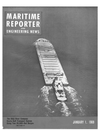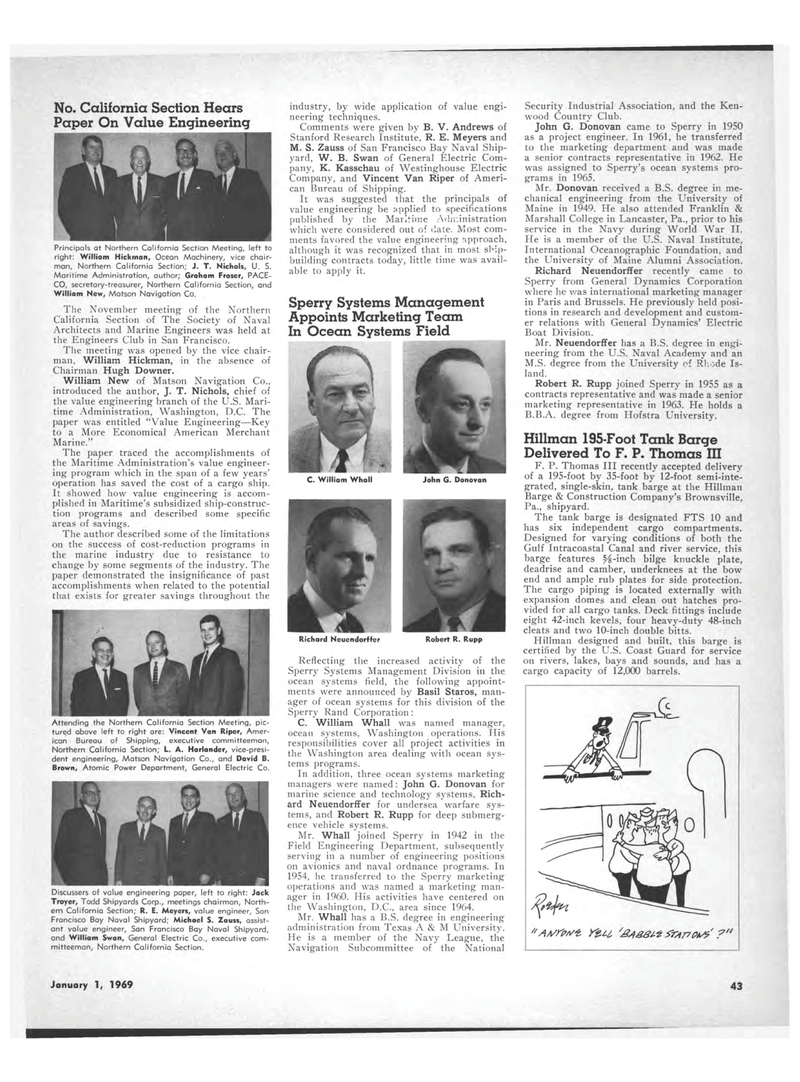
Page 41: of Maritime Reporter Magazine (January 1969)
Read this page in Pdf, Flash or Html5 edition of January 1969 Maritime Reporter Magazine
No. California Section Hears Paper On Value Engineering Principals at Northern California Section Meeting, left to right: William Hickman, Ocean Machinery, vice chair-man, Northern California Section; J. T. Nichols, U. S. Maritime Administration, author; Graham Fraser, PACE-CO, secretary-treasurer, Northern California Section, and William New, Matson Navigation Co. The November meeting of the Northern California Section of The Society of Naval Architects and Marine Engineers was held at the Engineers Club in San Francisco. The meeting was opened by the vice chair-man, William Hickman, in the absence of Chairman Hugh Downer. William New of Matson Navigation Co., introduced the author, J. T. Nichols, chief of the value engineering branch of the U.S. Mari-time Administration, Washington, D.C. The paper was entitled "Value Engineering?Key to a More Economical American Merchant Marine." The paper traced the accomplishments of the Maritime Administration's value engineer-ing program which in the span of a few years' operation has saved the cost of a cargo ship. It showed how value engineering is accom-plished in Maritime's subsidized ship-construc-tion programs and described some specific areas of savings. The author described some of the limitations on the success of cost-reduction programs in the marine industry due to resistance to change by some segments of the industry. The paper demonstrated the insignificance of past accomplishments when related to the potential that exists for greater savings throughout the Attending the Northern California Section Meeting, pic-tured above left to right are: Vincent Van Riper, Amer-ican Bureau of Shipping, executive committeeman, Northern California Section; L. A. Harlander, vice-presi-dent engineering, Matson Navigation Co., and David B. Brown, Atomic Power Department, General Electric Co. Discussers of value engineering paper, left to right: Jack Troyer, Todd Shipyards Corp., meetings chairman, North-ern California Section; R. E. Meyers, value engineer, San Francisco Bay Naval Shipyard; Michael S. Zauss, assist-ant value engineer, San Francisco Bay Naval Shipyard, and William Swan, General Electric Co., executive com-mitteeman, Northern California Section. industry, by wide application of value engi-neering techniques. Comments were given by B. V. Andrews of Stanford Research Institute, R. E. Meyers and M. S. Zauss of San Francisco Bay Naval Ship-yard, W. B. Swan of General Electric Com-pany, K. Kasschau of Westinghouse Electric Company, and Vincent Van Riper of Ameri-can Bureau of Shipping. It was suggested that the principals of value engineering be applied to specifications published by the Maritime Administration which were considered out of date. Most com-ments favored the value engineering approach, although it was recognized that in most ship-building contracts today, little time was avail-able to apply it. Sperry Systems Management Appoints Marketing Team In Ocean Systems Field t Richard Neuendorffer Robert R. Rupp Reflecting the increased activity of the Sperry Systems Management Division in the ocean systems field, the following appoint-ments were announced by Basil Staros, man-ager of ocean systems for this division of the Sperry Rand Corporation: C. William Whall was named manager, ocean systems, Washington operations. His responsibilities cover all project activities in the Washington area dealing with ocean sys-tems programs. In addition, three ocean systems marketing managers were named: John G. Donovan for marine science and technology systems, Rich-ard Neuendorffer for undersea warfare sys-tems, and Robert R. Rupp for deep submerg-ence vehicle systems. Mr. Whall joined Sperry in 1942 in the Field Engineering Department, subsequently serving in a number of engineering positions on avionics and naval ordnance programs. In 1954, he transferred to the Sperry marketing operations and was named a marketing man-ager in 1960. His activities have centered on the Washington, D.C., area since 1964. Mr. Whall has a B.S. degree in engineering administration from Texas A & M University. He is a member of the Navy League, the Navigation Subcommittee of the National Security Industrial Association, and the Ken-wood Country Club. John G. Donovan came to Sperry in 1950 as a project engineer. In 1961, he transferred to the marketing department and was made a senior contracts representative in 1962. He was assigned to Sperry's ocean systems pro-grams in 1965. Mr. Donovan received a B.S. degree in me-chanical engineering from the University of Maine in 1949. He also attended Franklin & Marshall College in Lancaster, Pa., prior to his service in the Navy during World War II. He is a member of the U.S. Naval Institute, International Oceanographic Foundation, and the University of Maine Alumni Association. Richard Neuendorffer recently came to Sperry from General Dynamics Corporation where he was international marketing manager in Paris and Brussels. He previously held posi-tions in research and development and custom-er relations with General Dynamics' Electric Boat Division. Mr. Neuendorffer has a B.S. degree in engi-neering from the U.S. Naval Academy and an M.S. degree from the University of Rhode Is-land. Robert R. Rupp joined Sperry in 1955 as a contracts representative and was made a senior marketing representative in 1963. He holds a B.B.A. degree from Hofstra University. Hillman 195-Foot Tank Barge Delivered To F. P. Thomas III F. P. Thomas III recently accepted delivery of a 195-foot by 35-foot by 12-foot semi-inte-grated, single-skin, tank barge at the Hillman Barge & Construction Company's Brownsville, Pa., shipyard. The tank barge is designated FTS 10 and has six independent cargo compartments. Designed for varying conditions of both the Gulf Intracoastal Canal and river service, this barge features ^Ms-inch bilge knuckle plate, deadrise and camber, underknees at the bow end and ample rub plates for side protection. The cargo piping is located externally with expansion domes and clean out hatches pro-vided for all cargo tanks. Deck fittings include eight 42-inch kevels, four heavy-duty 48-inch cleats and two 10-inch double bitts. Hillman designed and built, this barge is certified by the U.S. Coast Guard for service on rivers, lakes, bays and sounds, and has a cargo capacity of 12,000 barrels. January 1, 1969 43

 40
40

 42
42
